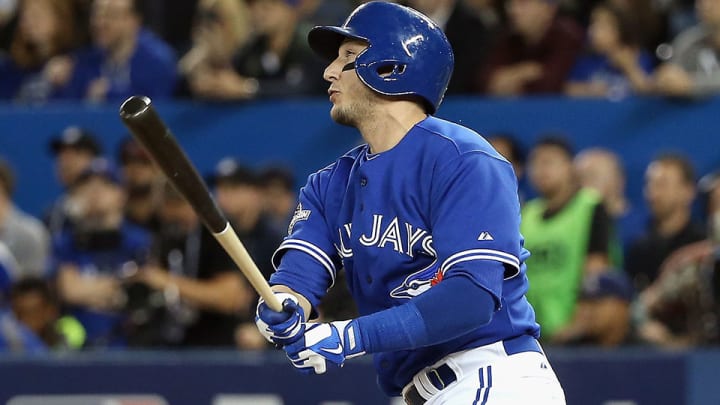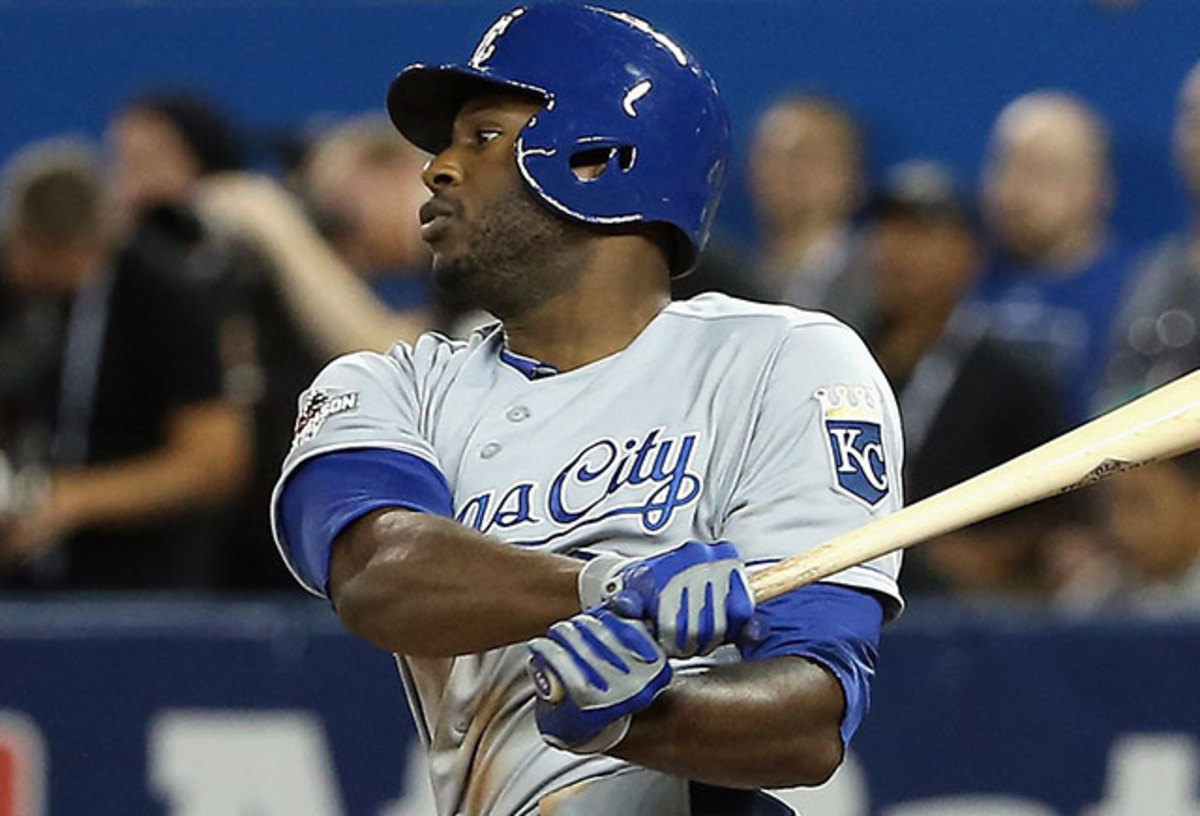Which team should Mets root for in ALCS: Blue Jays or Royals?

The Metscompleted their NLCS sweep of the Cubs on Wednesday night, giving them their first pennant since 2000. They won't play again until next Tuesday, the scheduled starting date of the World Series, but they won't know whether they'll be playing the Royals or Blue Jays until at least late Friday night, as Toronto's win in Game 5 forced the American League Championship Series back to Kansas City for Game 6.
As New York awaits the AL winner, should Terry Collins and company have any preference as to which team they'll face in the Fall Classic? Here's a look at some key specifics regarding each opponent.
Blue Jays
First off, this series matchup would offer a great narrative hook: the December 2012 blockbuster trade that sent newly crowned NL Cy Young Award winner R.A. Dickey to Toronto as part of a seven-player deal and brought back two highly-regarded prospects in pitcher Noah Syndergaard and catcher Travis d'Arnaud. The deal was made in large part due to payroll concerns as well as the likelihood that Dickey, a then-37-year-old knuckleballer, had reached his peak and had nowhere to go but down, and it has worked out very well in New York's favor.
Dickey's knuckleball mojo hasn't entirely translated to the AL East, where he's delivered a 3.95 ERA in 654 2/3 innings en route to 6.8 WAR in three seasons for $29 million—solid mid-rotation stuff, but hardly Cy Young caliber. After wobbling through 4 2/3 innings in his Division Series start, he didn't make it out of the second inning in Game 4 of the ALCS. Syndergaard (3.24 ERA and 2.1 WAR in 150 innings) and d'Arnaud (.268/.340/.485 with 12 homers and 1.7 WAR in 67 games), meanwhile, were both effective in partial seasons with the Mets and have made strong contributions in October as well.
Estrada shines and now Price must do the same to keep Blue Jays alive
Dickey's recent struggles underscore the fact that Toronto's pitching thus far in the postseason has been subpar. The team has allowed 5.30 runs per game in 10 games and has held its opponents to three runs or fewer only three times so far, including ALCS Game 5. Marcus Stroman and Marco Estrada are the only pitchers to deliver quality starts thus far; each has two apiece, while Dickey and ace David Price have each failed to do so in their two starts The latter hasn't turned in a quality start since Sept. 21, and including his strange relief outing in Game 4 of the Division Series in relief of Dickey, he has allowed 18 runs in his last 21 2/3 innings. As a unit, the Blue Jays' rotation has been touched for a 4.45 ERA, striking out just 6.4 per nine and allowing 1.1 homers per nine.
Price's usage out of the bullpen—which included warming up in Division Series Game 3 and ALCS Game 5 without getting into either game—is part of the ripple effect produced by the loss of lefty setup man Brett Cecil, whom manager John Gibbons said "could be the most worked and overworked guy in the postseason if things go our way.” Alas, Cecil suffered a left calf strain during Game 2 of the Division Series. There's hope that he could return for the World Series if the Jays make it that far, but no guarantees.
Resilient Blue Jays claw back into ALCS with Game 5 victory over Royals
Without Cecil, Toronto's sole lefty out of the bullpen has been Aaron Loup, who has four appearances totaling 2 1/3 innings but has been unavailable for several games due to a family emergency. Ryan Tepera, the righty reliever added to the roster when Cecil went down, held lefties to a .137/.254/.314 line in 59 plate appearances this year, but he took a pounding in his lone appearance thus far in the postseason, allowing seven of 12 batters to reach base en route to four runs in Tuesday's 14–2 blowout. Given all of that, Gibbons doesn't have many options to counter the Mets' key lefties—Curtis Granderson, Daniel Murphy and Lucas Duda, the latter of whom is the only one to hit lefties well during the regular season—in a late-inning matchup.
What's more, Gibbons can't have too much confidence in LaTroy Hawkins, who has allowed nine of the 14 batters he's faced to reach safely in three postseason appearances en route to seven runs; the 42-year-old righty looks as though he's reached the end of the line. The bullpen as a whole has been cuffed for a 5.50 ERA thus far in October, and while Toronto's relievers have allowed just one homer in 34 2/3 innings, they've whiffed just 6.3 per nine, a lower rate than the rotation. Unlike the Royals' relievers, they don't miss a ton of bats, with Loup (9.8 per nine), long man Liam Hendriks (9.9 per nine) and closer Roberto Osuna (9.7 per nine) the only ones who struck out anywhere close to a batter per inning.
• MORE MLB: Full postseason schedule, start times, TV listings

Royals
As bad as Toronto's rotation has been in the postseason, Kansas City's starting pitching has actually been worse so far, with just two quality starts out of 10 (one each by Johnny Cueto and Edinson Volquez), a collective 5.98 ERA and 1.1 homers allowed per nine innings. Unlike the Blue Jays, the Royals have at least missed bats, striking out 9.1 per nine, which offers some hope for a turnaround.
The difference-maker is the depth of the bullpen, which aside from the loss of closer Greg Holland to Tommy John surgery in September is basically the same unit that led the league in ERA (2.72) and ranked fourth in FIP (3.56). Thus far, Royals relievers have delivered a 2.65 ERA with 12.8 strikeouts per nine, though they've allowed 1.7 homers per nine collectively. Three of their seven homers allowed were served up by Ryan Madson, and two more came off Kris Medlen in a bullpen-saving–five-inning stint in relief of Cueto in ALCS Game 3, so it's not like they've all been backbreakers.
Where Daniel Murphy's postseason ranks among greatest of all time
The bullpen's depth affords manager Ned Yost the opportunity to do as he did with Chris Young in ALCS Game 4, pulling a wobbly starter before completing five innings without worrying about depleting his staff. In Medlen, he's got a capable long man. In Madson, Luke Hochevar, Kelvin Herrera and Wade Davis, he's got a stockpile of righties who can miss bats. In Danny Duffy and Franklin Morales, he's got options from the left side as well, particularly with the former's average velocity jumping to 97 mph in the shift to a relief role. That's an enviable collection relative to the rest of the field. Yost seems to fare better when he can take a push-button approach to the bullpen, with assigned roles by inning (Herrera for the seventh, Davis the eighth and Holland the ninth was the original recipe) instead of focusing on given matchups, but Kansas City's sheer advantage in manpower is a clear separator here.
The other thing to consider is the contact factor. The Royals put the ball in play a major league-high 74% of the time and struck out an MLB-low 15.9% of the time. Recent research by sabermetrician (and former Cardinals consultant) Mitchel Lichtman, conducted as part of an article by Ben Lindbergh, suggests that against power pitching—of which the Mets have no shortage—contact-oriented teams experience a smaller fall-off than do power-oriented teams such as the Blue Jays. Studying the 2010–15 period, Licthman found an 18-point advantage in weighted on-base average (wOBA) in favor of the contact-happy teams:
hitter type | overall | vs. finesse | vs. power | split |
|---|---|---|---|---|
Contact | .312 | .351 | .288 | .063 |
Non-contact | .317 | .359 | .278 | .081 |
Via Licthman and Lindbergh, that's enough to confer a slight advantage for the Royals. "It probably gives them an extra 2% or so to win a series,” he wrote—roughly half of what home field advantage (which either AL team will have against the Mets thanks to the outcome of the All-Star Game) provides. Meanwhile, in a piece for the Oct. 19 issue of Sports Illustrated, Joe Sheehan summarized his own research:
Since 2009, when rates began to spike, the team with the better regular-season contact rate is 30–12 in postseason series. The contact-rate theory has correctly predicted a majority of postseason series in each of the past six years and is an explanation for the success of the Giants over the past five years, as well as surprises like the 2011 Cardinals and the '14 Royals.
Between that and the two teams' bullpen situations, it appears that the Mets should be rooting for the Blue Jays on Friday and Saturday nights. Given their need to win two games on the road, the odds of Toronto getting through to the World Series are less than 25%, but either opponent is capable of beating New York: Both had better records and run differentials during the regular season, and the Blue Jays' third-order winning percentage of .627 was the best in baseball. Still, if there’s reason for the Mets to have a preference as to opponent, the arrow points to Toronto.
